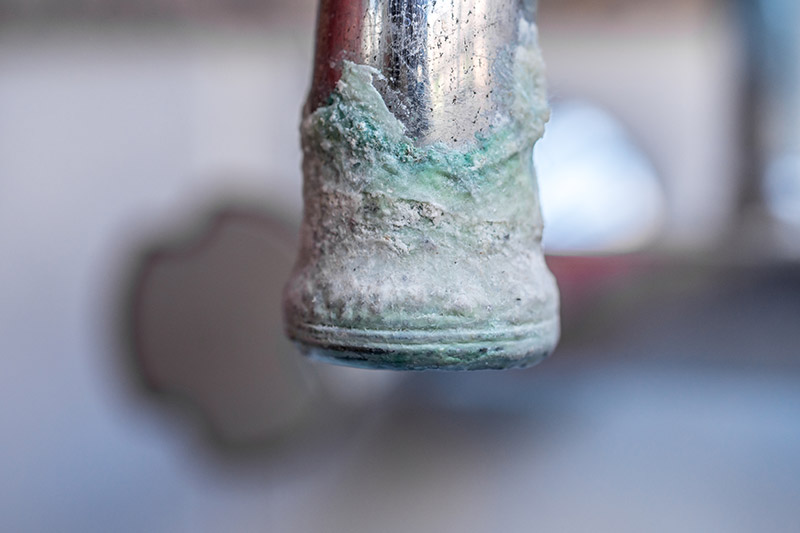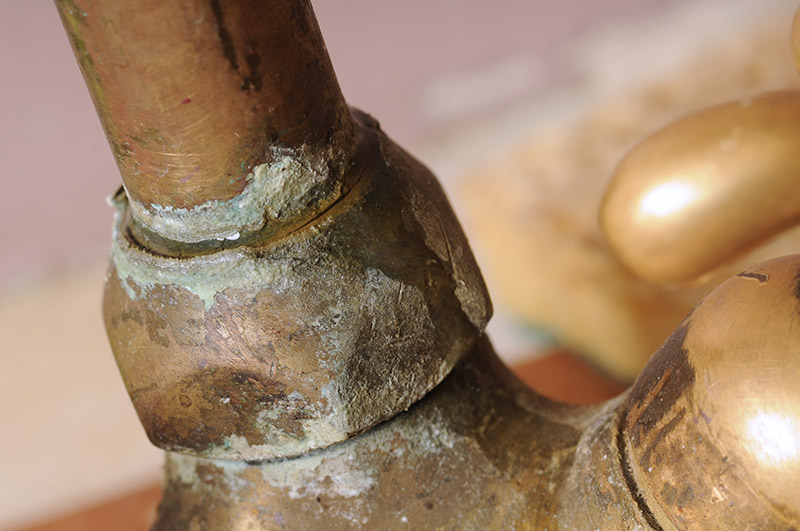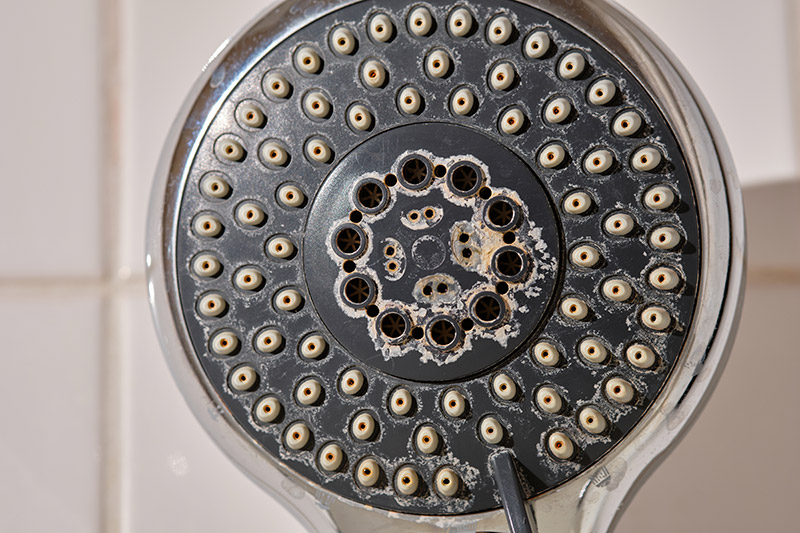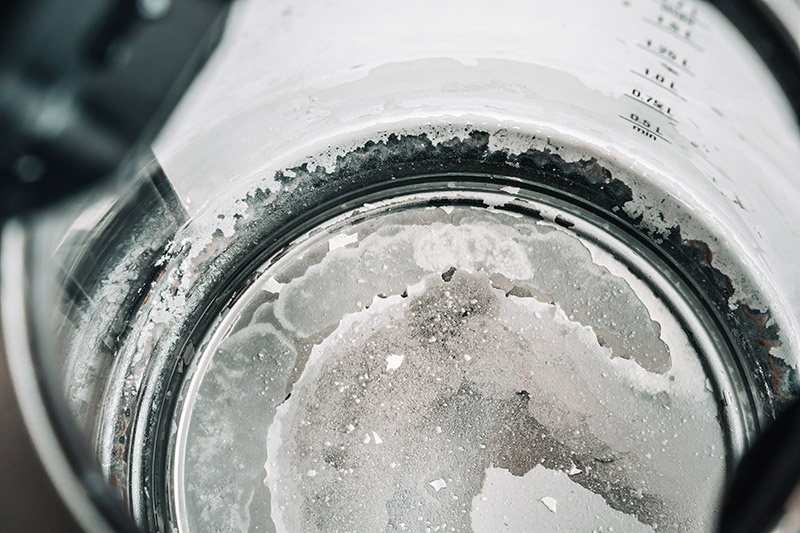Home Remedies for Limescale (Natural and Effective)
This page may contain affiliate links. If you make a purchase through one of our affiliate links, we’ll earn a commission, at no extra cost to you. For more details, please read our disclosure.

When it comes to hard water and limescale, many homeowners are at a loss for what to do. Limescale can build up on your faucets, showerheads, and other fixtures, making them less attractive and causing water flow problems.
In this article, we’ll share some natural and safe home remedies for limescale that should help get your fixtures looking new again!
What is Limescale (And What Causes It?)
Limescale is a chalky white substance that can build up on the inside of pipes and appliances that come into contact with hard water.
Hard water is water that contains high levels of minerals like calcium and magnesium. These minerals can deposit themselves on surfaces as the water evaporates, and over time, this build-up can become quite thick.
If you live in an area with hard water, it’s important to take measures to prevent or remove limescale buildup. Luckily, there are some simple home remedies that can help!
Places Where You’ll Find Limescale

If you have hard water, limescale can build up anywhere that water comes into contact with a surface. This includes:
- Faucets and taps
- Showerheads
- Bathtubs, showers, and sinks
- Toilets
- Appliances like coffee makers, dishwashers, and washing machines
- Kettles and teapots
- Irons
Is Limescale Bad for You?
Limescale itself is not harmful to people. However, it can cause problems with your plumbing and appliances.
The build-up of limescale can restrict water flow and reduce the efficiency of appliances. In extreme cases, it can even cause pipes to rupture.
If you have hard water, it’s important to clean away any limescale that you see in your home. Not only will this help keep your fixtures and appliances working properly, but it will also make your home look more attractive.
Home Remedies for Limescale
Now, let’s look at some simple ways to remove limescale with products you probably already have in your home. Thanks to these solutions, you won’t need to buy expensive cleaning products made to remove limescale. Not only will you save money, but you’ll also avoid using potentially harmful chemical-based cleaners.
Lemon Juice and Vinegar
Lemon juice and vinegar are two of the most popular home remedies for limescale. The citric acid in lemon juice is a natural descaling agent, while vinegar is a mild acid that can also help to break down limescale.
To use this method, simply mix equal parts lemon juice and vinegar in a spray bottle. Then, spray the solution onto any limescale-affected surfaces and let it sit for at least an hour.
Next, use a soft cloth or sponge to scrub away the loosened limescale. Finally, rinse the surface with clean water.
Related: How to Clean Copper Mugs
How to Remove Limescale from Dishwashers and Washing Machines
In addition to cleaning surfaces, the combination of lemon juice and vinegar can also be used to clean appliances like your dishwasher and washing machine.
To clean a dishwasher with this solution, mix equal parts lemon juice and vinegar and pour the mixture into the detergent compartment. Then, run the dishwasher through a regular cycle.
To clean a washing machine, add half a cup of lemon juice and half a cup of vinegar to the detergent compartment. Then, run the machine on a regular cycle using hot water.
Not only will this mixture help to remove limescale, but it will also keep your dishwasher and washing machine smelling clean and fresh.
How to Remove Limescale from Your Taps
The areas around your taps and faucets also tend to accumulate limescale build-up. For example, you may see the white chalky substance where your sink and faucet meet.
To clean this area, mix one part vinegar with two parts water in a bowl. Then, soak a cloth in the mixture and use it to wipe away any limescale.
If you have stubborn build-up, you can also try scrubbing the area with a toothbrush or an old toothbrush. Just be sure to rinse the area well when you’re finished.
Baking Soda and Vinegar
Baking soda and vinegar is another effective combination for removing limescale. The baking soda acts as a gentle abrasive, while the vinegar helps to break down the build-up.
To use this method, mix two parts baking soda with one part vinegar in a bowl. Then, apply the mixture to any limescale-affected areas and let it sit for at least 15 minutes.
After 15 minutes have passed, scrub the area with a sponge or brush. Finally, rinse away the mixture with clean water.
Related: How to Remove Rust from Knives with Baking Soda (and Other Natural Remedies)
How to Remove Limescale from Your Bathtub, Shower, or Sink
Limescale will often build up in bathtubs, showers, and sinks. The biggest issue here is that it’s unsightly. But thankfully, baking soda and vinegar and extremely effective for easily scrubbing away this build-up.
Follow the process listed above to clean your tubs, showers, and sinks with two parts baking soda and one part vinegar. You won’t need to do this every single time you clean, but once a month should be sufficient (or whenever you see build-up beginning to form).
Water and Vinegar
 Lucy’s Family Owned – Natural Distilled White Vinegar
Lucy’s Family Owned – Natural Distilled White Vinegar
You can also clean with a vinegar and water mixture as one of our home remedies for limescale. To do this, mix one part vinegar and one part water in a bowl or spray bottle.
How to Remove Limescale from a Shower Head

Limescale can also build up on your shower head, causing reduced water pressure. To clean a shower head with vinegar, simply fill a bag with one part vinegar and one part water and tie the bag around the shower head so that the shower head is submerged in the solution. If you’re able to remove the shower head, you can take it off and soak it in a bucket or bowl instead of using a bag.
Let the vinegar sit overnight. Then, remove the bag and use a brush to scrub away any loosened limescale. Finally, rinse the shower head with clean water.
Related: How to Clean a Bathtub Without Harsh Chemicals
How to Remove Limescale from Coffee Pots, Teapots, and Kettles

Teapots and kettles can also suffer from limescale build-up, especially if you have hard water. To clean a coffee pot, teapot or kettle, simply fill it with one part vinegar and one part water and let it soak for at least an hour.
After an hour has passed, scrub the inside of the pot or kettle with a brush to remove any loosened limescale. Finally, rinse the pot or kettle well with clean water.
How to Remove Limescale from Your Iron
Limescale can also build up on your iron, causing it to function less effectively. To clean an iron with vinegar, fill the iron’s reservoir halfway with a mixture of one part water and one part vinegar.
Then left the iron steam until the water/vinegar mixture is completely evaporated. Next, turn off the iron to let it cool. And when it is cool, wipe it down with a clean cloth.
Coke
Believe it or not, Coca-Cola can also be used to remove limescale. The reason why is because Coke contains phosphoric acid, which is a strong acidic cleaner.
How to Remove Limescale from a Toilet
Limescale can also build up in toilets, causing them to become stained and difficult to clean. To clean a toilet with Coke, simply pour a can of Coke around the rim of the toilet bowl.
Let the Coke sit for at least an hour (the longer, the better). Use a brush to scrub away any remaining limescale. Then, flush the toilet to rinse away the Coke.
How to Prevent Limescale
Now that you know how to remove limescale, let’s talk about how to prevent it from happening in the first place.
One of the simplest things you can do is wipe down your fixtures and appliances after every use. This will help to remove any water droplets or residue that could lead to limescale build-up.
In addition, you can also try using distilled water for cooking and cleaning. Distilled water doesn’t contain the minerals that can lead to limescale formation, so it’s a great way to prevent build-up.
Finally, consider investing in a water softener. A water softener will remove the minerals from your water, making it less likely to cause limescale build-up.
If you already have a water softener, make sure that it is regularly maintained and serviced to prevent any issues.
While you can’t completely prevent limescale from forming, taking these precautionary measures can help to reduce the amount of build-up that occurs over time.
Frequently Asked Questions
How do I get rid of limescale naturally?
There are several home remedies that can be used to remove limescale naturally. Vinegar, lemon, and baking soda are all effective for dealing with limescale build-up. Vinegar and lemon juice are effective at breaking it down, and baking soda is helpful when you need to scrub the surface.
How do professionals remove limescale?
Professionals usually remove limescale with a high-powered descaling solution. This solution is designed to break down the minerals that make up limescale, making it easier to remove. However, the home remedies covered in this article are also very effective, and they can save you a lot of money.
What removes limescale best?
There is no one “best” way to remove limescale. However, using a combination of vinegar and lemon juice is usually very effective. Baking soda can also be used to scrub away any stubborn build-up.
How do you get rid of heavy limescale build-up?
If you have heavy limescale build-up, you may need to use a professional descaling solution. However, home remedies can also be effective. Vinegar and lemon juice are both acidic and can break down the minerals that make up limescale. Baking soda is also abrasive and can help to scrub away any stubborn build-up.
Does baking soda remove limescale?
Baking soda can be used to remove limescale, but it is not as effective (on its own) as other home remedies. Baking soda is abrasive and can help to scrub away any stubborn build-up. Mixing two parts baking soda with one part vinegar will give you a more effective solution.
Does Coke clean limescale?
Coke can be used to clean limescale. The reason why is because Coke contains phosphoric acid, which is a strong acidic cleaner.
Does vinegar dissolve limescale?
Vinegar is an acidic substance that can break down the minerals that make up limescale. This makes it an effective home remedy for dealing with limescale build-up.
How do I stop limescale from forming?
One of the best ways to stop limescale from forming is to wipe down your fixtures and appliances after every use. In addition, you can also try using distilled water for cooking and cleaning. Finally, consider investing in a water softener.
Final Thoughts on Home Remedies for Limescale
Limescale can be a pain to deal with, but there are several home remedies for limescale that can help. Vinegar, lemon juice, and baking soda are all effective at removing limescale build-up. You can also try using distilled water to prevent limescale from forming in the first place. Investing in a water softener is also a good idea if you want to prevent limescale buildup.


